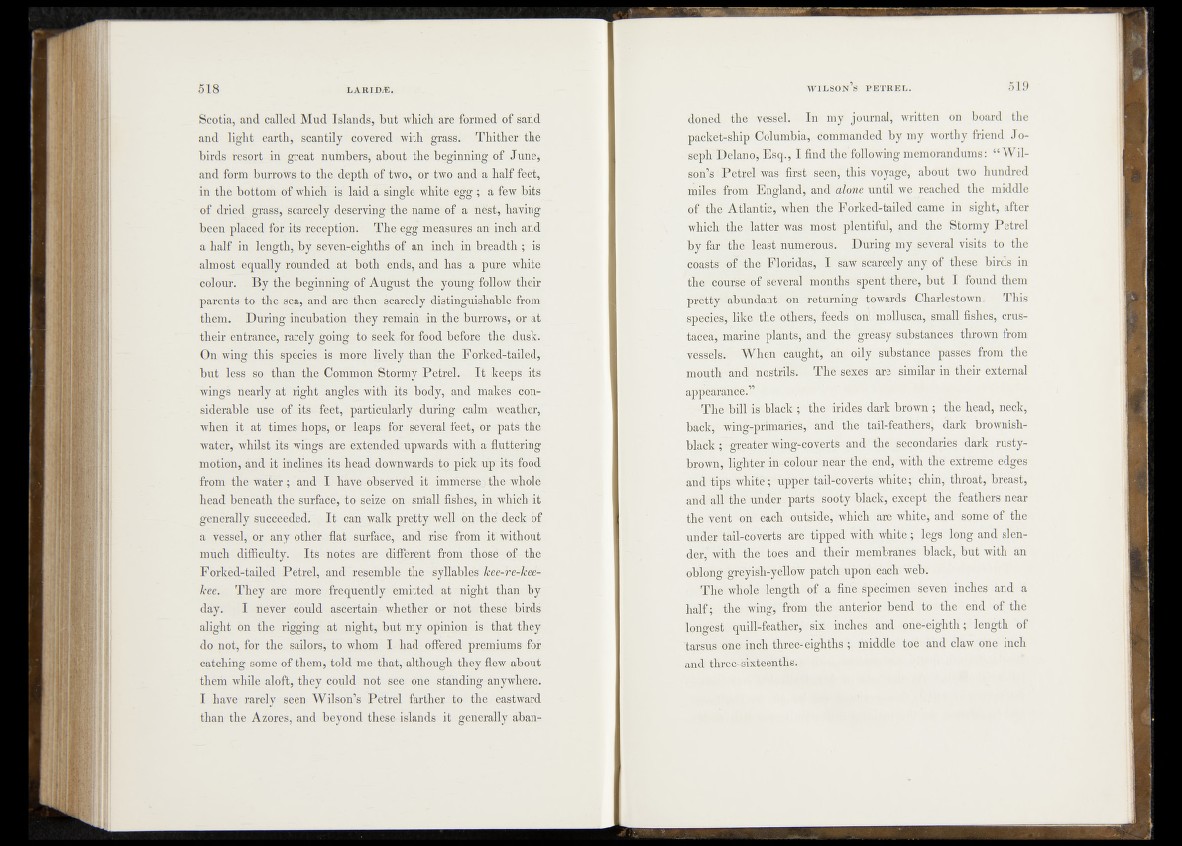
Scotia, and called Mud Islands, but which: are formed of-sand
and light earth, scantily covered "with grass. Thither' the
birds resort in great nuinberSf-about the beginning of June*
and form burrows to the depth of two, or tWo and a half feet,
in the bottom of which" is laidTh single white ^egg-; a few bits
of dried grass, scarcely deserving.tbe name of a nest, having
been placed for its receptidfii The.egg measures an inch and
a half in length, by seven-eighths -ef ■ an inch in brpadth ;"is
almost equally rounded at both ends, arid has a pure t^Mt^
colour. By the beginning-of August the. youngs fifth W'- their
parents to the sea, and are th endear cely distinguishable from
them. During'incubation they remain in the burrows, br-at
their entrance, rarely going to seek-fo-r food before the dusk.
On wing this species is more lively than the Forked-tailed,-
but less so than the Common Stormy P e tr e l. It keeps ibb
wings nearly at right angles with its body, and mak^g, considerable
use of-its-Jeet, particularly during calm-* we&ther,
when it at times-hops, or leaps for -seyeral feet-,-? or-pats the
water, whilst its wings are extended.upwards with a fluttering
motion, and it inclines its head downwardsto picknup'its, food
from the water; and I have-observed it immCrsi*) flic whole
head beneath the surface, "to seize on snlall fishes,-in which; it
generally succeeded. It can walk pretty well .on the deck of
a vessel, or any other flat surface, and rise from if without,
much difficulty. Its notes are different from those of-the-
Forked-tailed Petrel, and resemble the syllables kee-re-kee-
kee. They are more frequently emitted, at night than by
day. I never could ascertain whether or hot thesfl-birds
alight on the rigging at night, but my opinion is that they
do not, for the sailors, to whom I had offered premiums for-
catching some of them, told me that,, although they flew about
them while .aloft, they cppld not see one standing anywhere*
I have rarely seen Wilson’s Petrel farther to the eastward
than the Azores, and beyond these-islands it generally abaridoned
the vessel-. In my journal, written on board the
pack^ship "Columbia, commanded by my worthy friend Jo-
sephDelano, Esq., I find the*following memorandums: “Wilson’s
Petrel was first seen, this voyage, about two hundred
miles from England, and alone until we reached the middle
of the Atlantic, when the Forked-tailed came in sight, after
which-thev latter was most plentiful, and the Stormy Petrel
by far the least numerous. During my several visits to the
coasts of the Floridas, I saw scarcely any of these birds in
the * course «of several months spent there, but I found them
pretty--abundant1' on returning towards Charlestown. This
spe’oiSflike the lSaers, feeds oni - mollusca, small fishes, Crustacea,;
marine plants*« and the greasy substances thrown from
vessels* When caught, ah«oily substance passes from the
mouth and nost^fe' - The sexes are similar in their external
appearance.”
- -Thebilbis1 black ; the irides dark brown ; the head, neck,
back, wing-primaries, and the tail-feathers; dark brownish-
black ; -greater wing-coverts and the secondaries dark rusty-
jbrowh, lighter in^-colonr near the end, with the extreme edges
and tips white; upper tail-coverts white; chin, throat, breast,
and all the under parts sooty black, except the feathers near
the vent on each outside, which are white, and some of the
undet tail-coverts are tipped with white; legs long and slender,'
with the®'toes and their membranes black, but with an
oblong greyish-yellow patch upon each web.
. The whole- length of a fin% specimen seven inches and a
half; the wing; from the anterior bend to the end of the
longest quill-feather, six inches and one-eighth; length of
'tarsus one-inch three-eighths ; middle toe and claw one inch
and three-sixteenths.